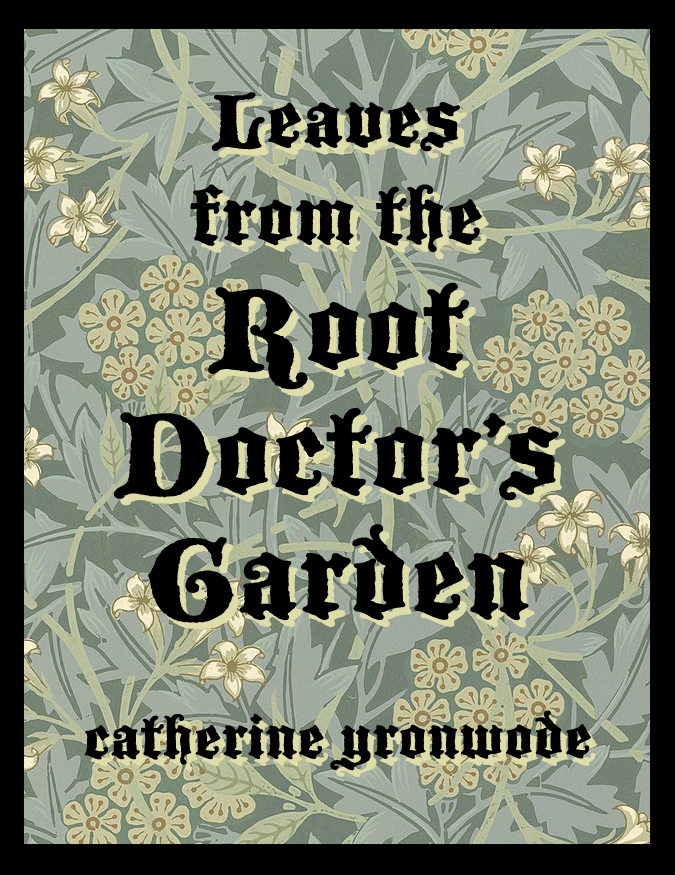THIS IS A PATREON PAGE
For a small monthly donation, my Patrons gain exclusive early access to my writings. Patreon subscribers also have access to my Private Patreon Forum, where we can discuss my research projects on the topics of divination, folklore, and magic.
• Patreon Date: March 7th, 2021.
• Public Date: March 7th, 2022.
In this installment of "Leaves from the Root Doctor's Garden" i offer a page the Herb Magic web site. As a Patreon supporter, you have access to the page one full year before the public does.
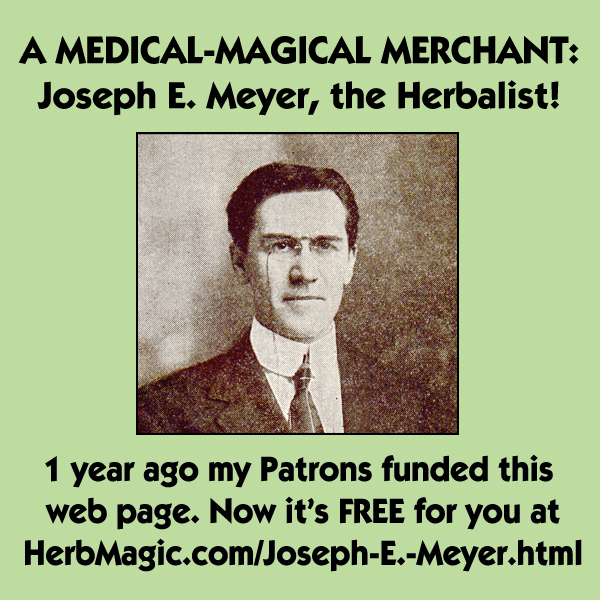
Joseph E. Meyer: The Herbalist |
This page opens up a biographical glimpse at Joseph E. Meyer, the single man most responsible for the continuance of basic herb and root magic within hoodoo into the mid 20th century, and the parts played by his sons and grandchildren in holding space for herbal medicine and herbal magic into the 21st century. There will be more pages, galleries of art, a bibliography, and much more. Along the way other herb stores will be sampled, and other proprietors given their just due and the interlinked community of growers, packagers, vendors, and authors will be explored.
"It's All Ephemera with Cat Yronwode"
To discuss this page and other Herb Magic Patreon pages with me, join my private Patreon Forum here:
Private Patreon Forum for"Leaves from the Root Doctor's Garden"
A Medical-Magical Merchant
Today i am going to tell you about a man who made an indelible impression on hoodoo in the 20th century. He was not a rootworker, nor was he African-American, but without him, the practice of herbal medicine and herbal magic in America would probably have come to an end shortly after the First World War.

His name was Joseph E. Meyer, and he called himself "The Herbalist." His story is one of hardship, talent, entrepreneurial spirit, good business sense, and, above all, kindliness to all with whom he came into contact. He had a sincere interest in folklore and a strong desire to treat everyone honestly, no matter what their religion, culture, gender, ethnicity, or race.
Meyer lived, worked, and ultimately thrived during a time when the government and the newly-powerful American Medical Association joined forced in a forceful attempt to erase both herbal medicine and natural magic by essentially labelling home remedies and ingredients that comprised them to be inherently fraudulent and ineffective. Because herbs could not be patented, and large pharmaceutical interests competed and colluded to produce patented and trade-marked medicines that had to be purchased from their factories, simple over-the-counter medications such as laxatives, liniments, analgesics, and digestive aids were no longer to be made at home from roots and herbs. Instead, they were to be purchased at a pharmacy in the form of white pills and brown syrups. The United States Post Office was called into action to halt the shipment of plant matter deemed to be sold under false representation, and when it came to roots used in magic, particularly in hoodoo, it became illegal to even explain how they were employed in spells, unless the explanations took care to deprecate the presumed ignorance, quakery, and bad faith of the conjure practitioners who prescribed them.
Against this historic backdrop, which also happened to include the rise of Jim Crow laws and systemic racism, Joseph Meyer fought a long, and eventually successful, series of battles to ensure that Americans' First Amendent right to free speech made it possible to discuss medical treatments that made use of herbs and to be able to transfit folkloric practices associated with luck, protection, and prayer. Among other strategies, me made sure that every herb that he sold came in a package that bore his trademark, and that the plant matter was accurately described by name, so that herb doctors could not be accused of adulterating or mislabelling their products.
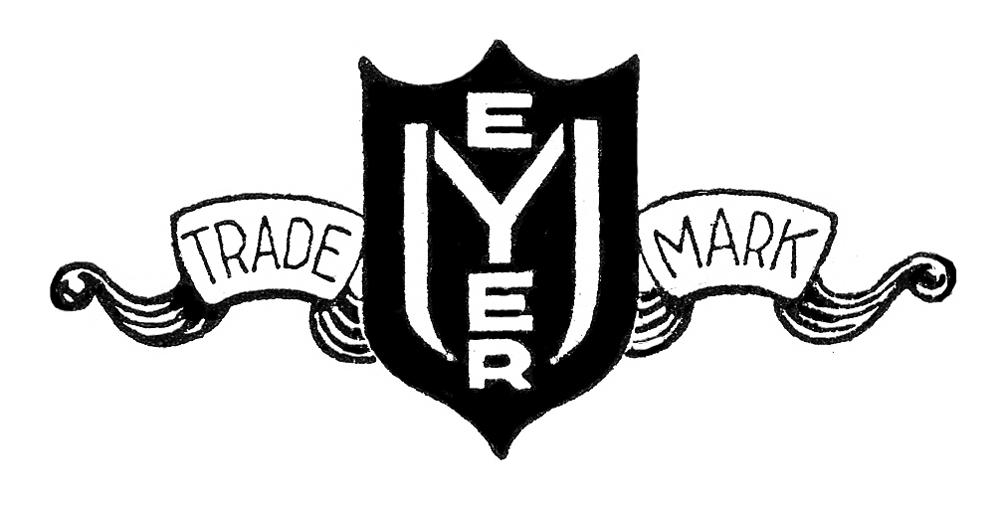
As a young woman, coming on the scene of both herbal medicine and herb magic during the 1960s, i was too late to meet Joseph Meyer -- he died in 1950 -- but the companies he and his family members ran, and the information they made available for free through their catalogues and yearly almanacs, provided me with a solid foundation in world-wide folk medical formulas and also world-wide spells and customs in which herbs, roots, seeds, and nuts were used in spiritual and occult ways. Many other companies provided similar Moon Sign and Moon Phase almanacs, but only "The Herbalist Almanac" and its adjuncts provided lists of aromatic herbs, herbs to use for dyes, magical potions from the Renaissance, and the lore of curios like Master of the Woods, Southern John the Conqueror, and Holy Basil. Every dated "Herbalist Almanac" carried a unique lunar calendar, which was good for but one year, but the articles themselves never repeated, and collecting the entire run became imperative to a student of my temperament.
I devoured every page. I wrote out long index entries on what i found of use, from palmistry to periwinkle and from orris root to iron deficiency anaemia. I constantly upgraded the old, torn, worn copies i found at yard sales, hoping to establish a complete collection in very good or better condition. I learned that the early issues, with cover art signed "C. Meyer," had been drawn by Joseph's son Clarence Meyer, who also provided interior artwork and the covers for a variety of other Indiana Botanic Gardens publications throughout the years.
Along the way i found that i was not the only person who had accumulated long runs of "The Herbalist Almanac." Even to this day one can sometimes find runs of 35 to 45 years' worth of issues, underlined, written in, and annotated by those who valued them enough to keep for a lifetime.
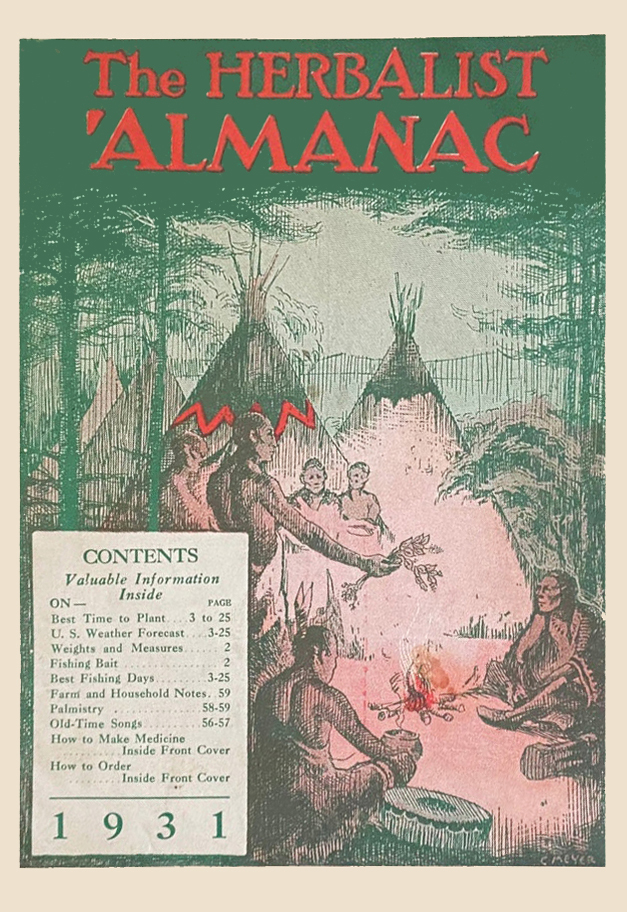
Joseph Meyer is not an obscure personage, nor is my championing of his life and career an act of revelation or overdue recognition. There is a Wikipedia article about him, for instance, and his family still owns and operates the company he founded. But for those who think that hoodoo was held and preserved only in the hands of a few rural conjure doctors who harvested all their own remedies from field and forest, and for those who have ever actually stopped to ask, "Where did this root come from?" it is important to understand the impact this one great-hearted man had on our traditions.
I would like to start this series of articles on Joseph E. Meyer with a memorial tribute given by his employees and family members upon his death. It appeared in the 1951 edition of "The Herbalist Almanac" as a four-page center-spread. It doesn't tell all the story, but it is a good place to start.
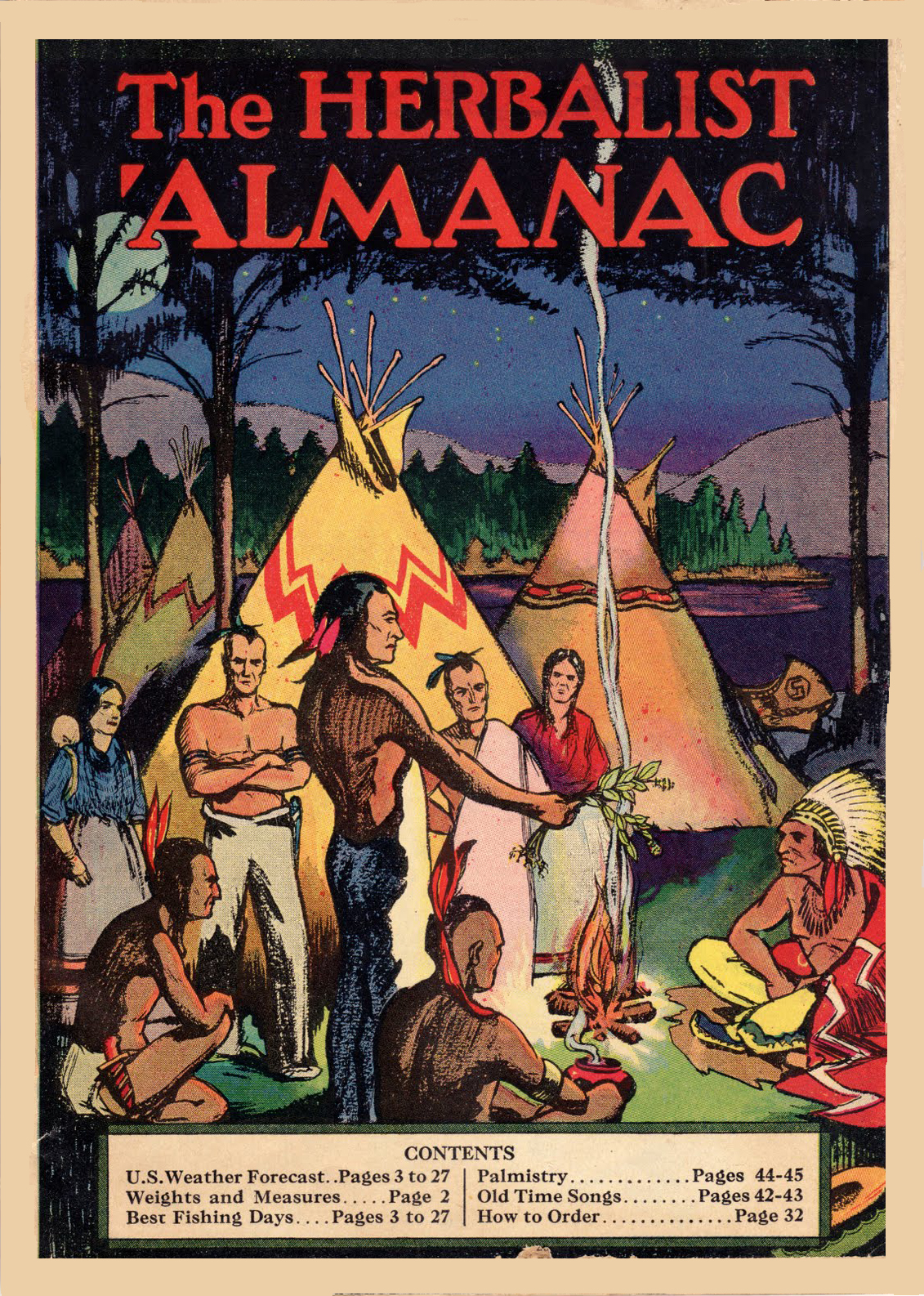
IN MEMORIAM
In the infinite wisdom of the Almighty Father, there has been taken from our midst Joseph E. Meyer.
We'll not forget him, we who stay,
To work a little longer here.
His name, his deeds, his kindness we lay
On memory's tablet bright and clear.
His passing saddened the hearts of all the employees of the Indiana Botanic Gardens, of which he was the founder and whose growth he guided from its inception with persistent solicitude.
We shall ever treasure the memory of Joseph E. Meyer and his kind acts of helpfulness in service to humanity. His wise counsel always enhanced the welfare of those who were privileged to know him. We hope we can continue the journey in the path he so ably cleared.
To the bereaved family and countless friends, we extend deepest sympathy.
Sincerely,
EMPLOYEES,
INDIANA BOTANIC GARDENS.
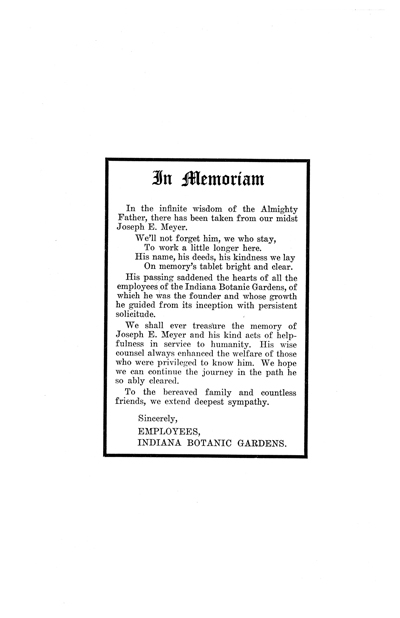
Joseph E. Meyer was born in Kenosha, Wisconsin, September 5, 1878. He spent most of his early boyhood in Milwaukee, where his father gave violin lessons, and operated a photography studio. Joseph loved to go with his father on excursions in the fields and forests. While father took pictures, the son wandered among the multitudinous species of plants. It was a very hot afternoon in the summer of 1887 when on one of these excursions with horse and buggy, Joseph's father collapsed from sun-stroke. The boy drove his unconscious father home where he died several days later. For two years the mother tried to keep her family of six children together. Tragedy came again when one of the sons drowned. The mother's illness finally broke up her family. Joseph, the eldest of her children, was sent with a brother to an orphanage at St. Francis. The sisters were separated and sent to live among relatives.
In the orphanage, Joseph was given a practical education and was taught the printing trade. He was quiet and studious. According to his brother, "Joe never got a licking like I did, but then he was always well behaved." Life among two hundred boys changed the youth to a serious minded young man. At sixteen he was already a proficient printer -- having set up and printed a German-English Prayer Book. Joseph developed a strong individualistic character and will power, which carried him through almost unsurmountable difficulties of later years.
On a cold December night in 1895, a devastating fire swept through the printery and dormitories. Joseph decided that the orphanage, without a print shop, could no longer be of any help to him. With a few light clothes he managed to save, he left the smoldering ruins and walked all night and early morning hours to reach his grandmother's home in north Milwaukee. Upon her advice he worked without pay as a printer, in order to acquire working experience. His first earned salary was $2.00 per week. With this money, courage, and a soaring ambition, Joseph left his grandmother to work out his own salvation. He worked for several years in print shops, then with the financial help of his grandmother, Joseph opened his own shop in a basement on East Water Street. Times were very bad in Milwaukee, even among old established businesses. Several times the little printer was reduced to near starvation. He slept in his shop and often went without meals. He hung on tenaciously from job to job, occasionally getting substantial work that gave him renewed hope for the future.
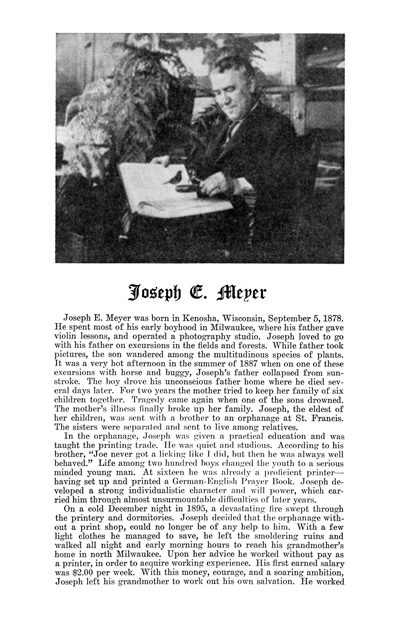
During these hard years, Joseph met the girl of his dreams. In 1900 he married her and they struggled on together. In the next five years, three sons were born. Conditions in Milwaukee did not improve. Joseph heard that Chicago had more possibilities for printers, so he sold his press, left the growing family with relatives and went to the big city. As soon as he found work he sent for his wife and children. Another son was added to his brood in 1906. The family was in Chicago two years when a paralyzing strike came. Joseph had to keep his family fed, so he moved on to near-by Hammond, Indiana, to work in the print shop of a local daily paper.
Hammond proved to be the turning point in Joseph's life. From his salary of $18.50 per week, he managed to save enough to buy an old press and type, which he installed in a tiny bedroom of his home. Each night "after the kids were in bed" Joseph studied and worked long hours on "The Sealed Book" -- his first literary effort. Joseph had very little type, so he set his book up two pages at a time. After the two pages were printed, he distributed the type and immediately began working on the next two pages with the same type. This went on until a 125 page book was printed -- the last few pages showed a well worn type. "The Sealed Book" exposed gaming devices which were so much used in those days. The material was gathered through printing trade contacts while working in the big city. The sale of this book gave Joseph his first real money to carry out ideas he had been harboring and nursing for many years.
It was back in the orphanage days that Joseph discovered what he wanted to make his life work. It began when he took ill in the orphanage. Through long convalescing days the lonely boy's only recreation was reading a book on materia medica. He read it from cover to cover -- then re-read it. He was especially interested in the passages on herbs, and was surprised to learn that what most people considered worthless weeds growing in every field had been used since time immemorial in the conquest of disease. Since the orphanage days Joseph studied herbs from all sources possible. He believed infinitely that God put plants on this earth for medicine as well as food.
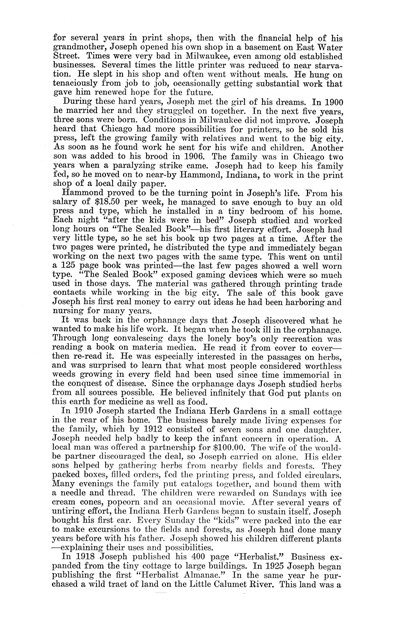
In 1918 Joseph published his 400 page "Herbalist." Business expanded from the tiny cottage to large buildings. In 1925 Joseph began publishing the first "Herbalist Almanac." In the same year he purchased a wild tract of land on the Little Calumet River. This land was a herbalist's dream, with the profusion of medicinal plants and virgin forest. It appears to have been an ancient Indian site, as several Indian relics were found thereon. In 1926 the beautiful English gabled building was built. The new home of the Indiana Herb Gardens was changed to Indiana Botanic Gardens. In the years following Joseph was active in laying out and stocking the botanical gardens. He traveled to all parts of North America to gather material and information on native plants, and their uses by the Indians. Mail poured in from all parts of the world, from universities, libraries, botanists and people from all ranks of life. In 1932 Joseph traveled in Europe to seek rare herbals for the Indiana Botanic Garden library, which today ranks with the finest collections in the world.
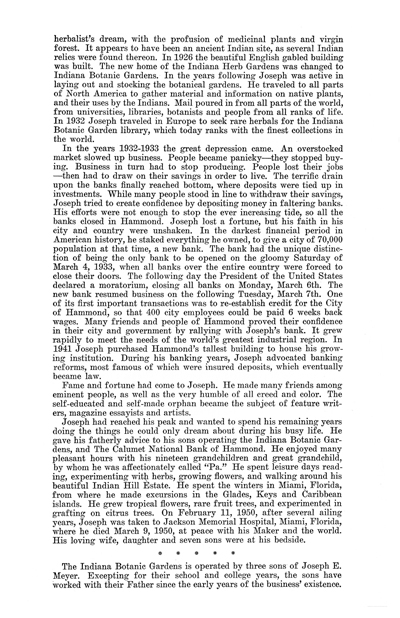
In the years 1932-1933 the great depression came. An overstocked market slowed up business. People became panicky--they stopped buying. Business in turn had to stop producing. People lost their jobs -- then had to draw on their savings in order to live. The terrific drain upon the banks finally reached bottom, where deposits were tied up in investments. While many people stood in line to withdraw their savings, Joseph tried to create confidence by depositing money in faltering banks. His efforts were not enough to stop the ever increasing tide, so all the banks closed in Hammond. Joseph lost a fortune, but his faith in his city and country were unshaken. In the darkest financial period in American history, he staked everything he owned, to give a city of 70,000 population at that time, a new bank. The bank had the unique distinction of being the only bank to be opened on the gloomy Saturday of March 4, 1933, when all banks over the entire country were forced to close their doors. The following day the President of the United States declared a moratorium, closing all banks on Monday, March 6th. The new bank resumed business on the following Tuesday, March 7th. One of its first important transactions was to re-establish credit for the City of Hammond, so that 400 city employees could be paid 6 weeks back wages. Many friends and people of Hammond proved their confidence in their city and government by rallying with Joseph's bank. It grew rapidly to meet the needs of the world's greatest industrial region. In 1941 Joseph purchased Hammond's tallest building to house his growing institution. During his banking years, Joseph advocated banking reforms, most famous of which were insured deposits, which eventually became law.
Fame and fortune had come to Joseph. He made many friends among eminent people, as well as the very humble of all creed and color. The self-educated and self-made orphan became the subject of feature writers, magazine essayists and artists.
Joseph had reached his peak and wanted to spend his remaining years doing the things he could only dream about during his busy life. He gave his fatherly advice to his sons operating the Indiana Botanic Gardens, and The Calumet National Bank of Hammond. He enjoyed many pleasant hours with his nineteen grandchildren and great grandchild, by whom he was affectionately called "Pa." He spent leisure days reading, experimenting witli herbs, growing flowers, and walking around his beautiful Indian Hill Estate. He spent the winters in Miami, Florida, from where he made excursions in the Glades, Keys and Caribbean islands. He grew tropical flowers, rare fruit trees, and experimented in grafting on citrus trees. On February 11, 1950, after several ailing years, Joseph was taken to Jackson Memorial Hospital, Miami, Florida, where he died March 9, 1950, at peace with his Maker and the world. His loving wife, daughter and seven sons were at his bedside.
The Indiana Botanic Gardens is operated by three sons of Joseph E. Meyer. Excepting for their school and college years, the sons have worked with their Father since the early years of the business' existence.
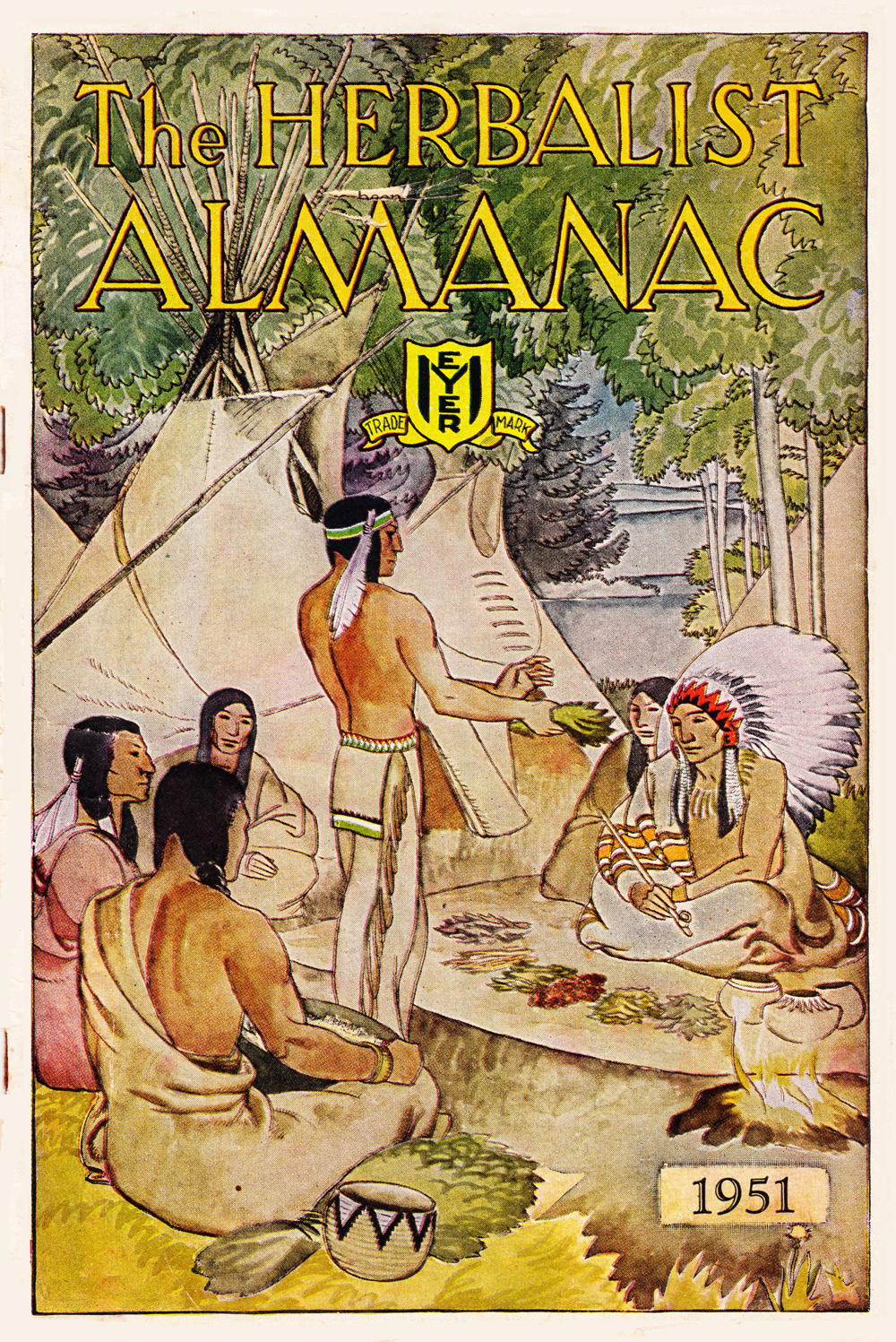
Legacy
Joseph E. Meyer's Indiana Botanic Gardens, and his family's other enterprises, outlived him and prospered.
What the above memorial tributes do not explain, perhaps because the authors were too near the source to appreciate it, is that Joseph Meyer was a very gifted author and an excellent typesetter and printer. He had a personable and no-nonsense way of explaining everything from ancient Egyptian perfumes to the latest outrage perpetrated upon herb growers by the Food and Drug Administration. He was a historian, an archivist, a political scrapper, and a man of fine aesthetic taste and sensitivity. Where other almanacs gave you the daily Moon signs and a running account of predicted weather patterns, Joseph Meyer drew you in with recipes and formulas contributed by customers like "Old Tamarack," the Northwestern trapper, and with fascinating snippets of herb lore from rare library volumes of years long past.
By the time i arrived on the scene, Meyer's herb company was known all around the nation as the best retail source for culinary, medical, and magical herbs, roots, seeds, and flowers. Other companies also supplied high quality crude herbs, but most of them put more of an emphasis on proprietary compounds and formulas for ailments than they did on supplying magical herbs such as High John the Conqueror and Devil's Shoe Strings. I bought from one and all, but i was always happiest with the almanacs and packages of freshly dried herbs from Indiana Botanic Gardens.
During the 1970s and 1980s, Clarence and David Meyer produced some wonderful collections of the writings of Joseph Meyer, rescuing gems of wisdom and folkloric knowledge from the back pages of "The Herbalist Almanac." I will return to these books later, but suffice it to say that the Meyerbooks offshoot company which produced these collections was a boon to hippie herbalists and root doctors alike. An illustrated and annotated bibliography will follow.
To my surprise, while the flame of Joseph Meyer's crusading spirit was being kept alive by dirt-hippies and conjure doctors, in the halls of the United States Congress he was also being remembered for his impeccable business sense and fair dealing. Here is a heartfelt "Tribute to Joseph Meyer" that was read into the Congressional Record of the United states in 1998 by Hon. Peter J. Visclosky, the Democratic Party U.S. Representative for Indiana's 1st congressional district, who served Northwest Indiana from 1985 until his retirement in 2021. One hundred and twenty years had passed since Meyer's birth, and almost fifty years since his death, but in Indiana he was not forgotten.
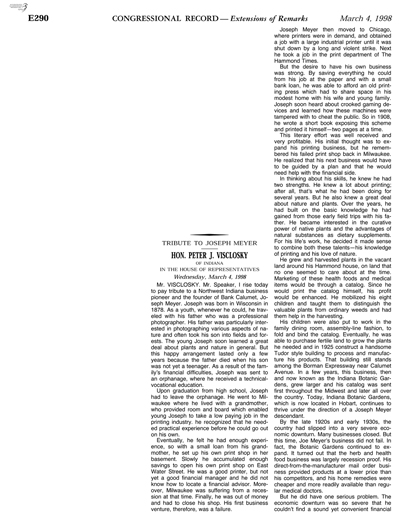
Tribute to Joseph E. Meyer by Rep. Peter J. Visclosky
CONGRESSIONAL RECORD -- Extensions of Remarks March 4, 1998
TRIBUTE TO JOSEPH MEYER
HON. PETER J. VISCLOSKY OF INDIANA
IN THE HOUSE OF REPRESENTATIVES
Wednesday, March 4, 1998
[https://www.congress.gov/crec/1998/03/04/CREC-1998-03-04-pt1-PgE290-4.pdf]
Mr. VISCLOSKY.
Mr. Speaker, I rise today to pay tribute to a Northwest Indiana business pioneer and the founder of Bank Calumet, Joseph Meyer. Joseph was born in Wisconsin in 1878. As a youth, whenever he could, he traveled with his father who was a professional photographer. His father was particularly interested in photographing various aspects of nature and often took his son into fields and forests. The young Joseph soon learned a great deal about plants and nature in general. But this happy arrangement lasted only a few years because the father died when his son was not yet a teenager. As a result of the family's financial difficulties, Joseph was sent to an orphanage, where he received a technical vocational education.
Upon graduation from high school, Joseph had to leave the orphanage. He went to Milwaukee where he lived with a grandmother, who provided room and board which enabled young Joseph to take a low paying job in the printing industry. He recognized that he needed practical experience before he could go out on his own.
Eventually, he felt he had enough experience, so with a small loan from his grandmother, he set up his own print shop in her basement. Slowly he accumulated enough savings to open his own print shop on East Water Street. He was a good printer, but not yet a good financial manager and he did not know how to locate a financial advisor. Moreover, Milwaukee was suffering from a recession at that time. Finally, he was out of money and had to close his shop. His first business venture, therefore, was a failure.
Joseph Meyer then moved to Chicago, where printers were in demand, and obtained a job with a large industrial printer until it was shut down by a long and violent strike. Next he took a job in the print department of The Hammond Times.
But the desire to have his own business was strong. By saving everything he could from his job at the paper and with a small bank loan, he was able to afford an old printing press which had to share space in his modest home with his wife and young family. Joseph soon heard about crooked gaming devices and learned how these machines were tampered with to cheat the public. So in 1908, he wrote a short book exposing this scheme and printed it himself -- two pages at a time.
This literary effort was well received and very profitable. His initial thought was to expand his printing business, but he remembered his failed print shop back in Milwaukee. He realized that his next business would have to be guided by a plan and that he would need help with the financial side.
In thinking about his skills, he knew he had two strengths. He knew a lot about printing; after all, that's what he had been doing for several years. But he also knew a great deal about nature and plants. Over the years, he had built on the basic knowledge he had gained from those early field trips with his father. He became interested in the curative power of native plants and the advantages of natural substances as dietary supplements. For his life's work, he decided it made sense to combine both these talents--his knowledge of printing and his love of nature.
He grew and harvested plants in the vacant land around his Hammond house, on land that no one seemed to care about at the time. Marketing of these health foods and medical items would be through a catalog. Since he would print the catalog himself, his profit would be enhanced. He mobilized his eight children and taught them to distinguish the valuable plants from ordinary weeds and had them help in the harvesting.
His children were also put to work in the family dining room, assembly-line fashion, to fold and bind the catalog. Eventually, he was able to purchase fertile land to grow the plants he needed and in 1925 construct a handsome Tudor style building to process and manufacture his products. That building still stands along the Borman Expressway near Calumet Avenue. In a few years, this business, then and now known as the Indiana Botanic Gardens, grew larger and his catalog was sent first throughout the Midwest and later all over the country. Today, Indiana Botanic Gardens, which is now located in Hobart, continues to thrive under the direction of a Joseph Meyer descendant.
By the late 1920s and early 1930s, the country had slipped into a very severe economic downturn. Many businesses closed. But this time, Joe Meyer's business did not fail. In fact, the Botanic Gardens continued to expand. It turned out that the herb and health food business was largely recession proof. His direct-from-the-manufacturer mail order business provided products at a lower price than his competitors, and his home remedies were cheaper and more readily available than regular medical doctors.
But he did have one serious problem. The economic downturn was so severe that he couldn't find a sound yet convenient financial institution to hold his deposits. In fact, in the year 1933, Joseph Meyer was faced with a particular dilemma in that all of Hammond's banks had failed. He had no local place to deposit the dimes and quarters and dollars that were arriving in cash every day at his plant.
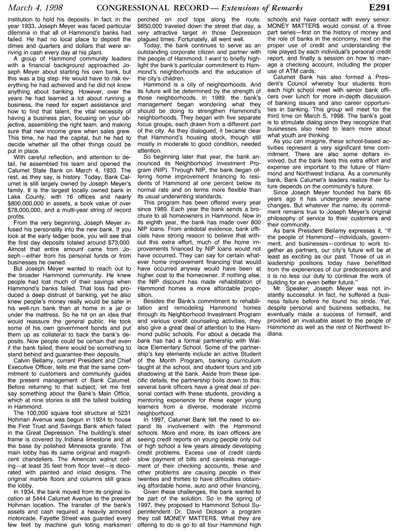
A group of Hammond community leaders with a financial background approached Joseph Meyer about starting his own bank, but this was a big step. He would have to risk everything he had achieved and he did not know anything about banking. However, over the years he had learned a lot about running a business, the need for expert assistance and how to find that talent, the vital necessity of having a business plan, focusing on your objective, assembling the right team, and making sure that new income grew when sales grew. This time, he had the capital, but he had to decide whether all the other things could be put in place.
With careful reflection, and attention to detail, he assembled his team and opened the Calumet State Bank on March 4, 1933. The rest, as they say, is history. Today, Bank Calumet is still largely owned by Joseph Meyer's family. It is the largest locally owned bank in Lake County, with 16 offices and nearly $800,000,000 in assets, a book value of over $78,000,000, and a multi-year string of record profits.
From the very beginning, Joseph Meyer infused his personality into the new bank. If you look at the early ledger book, you will see that the first day deposits totaled around $73,000. Almost that entire amount came from Joseph--either from his personal funds or from businesses he owned.
But Joseph Meyer wanted to reach out to the broader Hammond community. He knew people had lost much of their savings when Hammond's banks failed. That loss had produced a deep distrust of banking, yet he also knew people's money really would be safer in his well-run bank than at home in a jar or under the mattress. So he hit on an idea that would reassure the general public. He took some of his own government bonds and put them up as collateral to back the bank's deposits. Now people could be certain that even if the bank failed, there would be something to stand behind and guarantee their deposits.
Calvin Bellamy, current President and Chief Executive Officer, tells me that the same commitment to customers and community guides the present management of Bank Calumet. Before returning to that subject, let me first say something about the Bank's Main Office, which at nine stories is still the tallest building in Hammond.
The 100,000 square foot structure at 5231 Hohman Avenue was begun in 1924 to house the First Trust and Savings Bank which failed in the Great Depression. The building's steel frame is covered by Indiana limestone and at the base by polished Minnesota granite. The main lobby has its same original and magnificent chandeliers. The American walnut ceiling--at least 35 feet from floor level--is decorated with painted and inlaid designs. The original marble floors and columns still grace the lobby.
In 1934, the bank moved from its original location at 5444 Calumet Avenue to the present Hohman location. The transfer of the bank's assets and cash required a heavily armored motorcade. Fayette Street was guarded every few feet by machine gun toting marksmen perched on roof tops along the route. $650,000 traveled down the street that day, a very attractive target in those Depression plagued times. Fortunately, all went well.
Today, the bank continues to serve as an outstanding corporate citizen and partner with the people of Hammond. I want to briefly highlight the bank's particular commitment to Hammond's neighborhoods and the education of the city's children.
Hammond is a city of neighborhoods. And its future will be determined by the strength of those neighborhoods. In 1989, the bank's management began wondering what they should be doing to strengthen Hammond's neighborhoods. They began with five separate focus groups, each drawn from a different part of the city. As they dialogued, it became clear that Hammond's housing stock, though still mostly in moderate to good condition, needed attention.
So beginning later that year, the bank announced its Neighborhood Investment Program (NIP). Through NIP, the bank began offering home improvement financing to residents of Hammond at one percent below its normal rate and on terms more flexible than its usual underwriting standards.
This program has been offered every year since 1989. Each year the bank sends a brochure to all homeowners in Hammond. Now in its eighth year, the bank has made over 800 NIP loans. From antidotal evidence, bank officials have strong reason to believe that without this extra effort, much of the home improvements financed by NIP loans would not have occurred. They can say for certain whatever home improvement financing that would have occurred anyway would have been at higher cost to the homeowner. If nothing else, the NIP discount has made rehabilitation of Hammond homes a more affordable proposition.
Besides the Bank's commitment to rehabilitation and remodeling Hammond homes through its Neighborhood Investment Program and various credit counseling activities, they also give a great deal of attention to the Hammond public schools. For about a decade the bank has had a formal partnership with Wallace Elementary School. Some of the partnership's key elements include an active Student of the Month Program, banking curriculum taught at the school, and student tours and job shadowing at the bank. Aside from these specific details, the partnership boils down to this: several bank officers have a great deal of personal contact with these students, providing a mentoring experience for these eager young learners from a diverse, moderate income neighborhood.
In 1997, Calumet Bank felt the need to expand its involvement with the Hammond schools. More and more, its loan officers are seeing credit reports on young people only out of high school a few years already developing credit problems. Excess use of credit cards slow payment of bills and careless management of their checking accounts, these and other problems are causing people in their twenties and thirties to have difficulties obtaining affordable home, auto and other financing.
Given these challenges, the bank wanted to be part of the solution. So in the spring of 1997, they proposed to Hammond School Superintendent Dr. David Dickson a program they call MONEY MATTER$. What they are offering to do is go to all four Hammond high schools and have contact with every senior. MONEY MATTER$ would consist of a three part series -- first on the history of money and the role of banks in the economy, next on the proper use of credit and understanding the role played by each individual's personal credit report, and finally a session on how to manage a checking account, including the proper use of ATM cards.
Calumet Bank has also formed a President's Council whereby four students from each high school meet with senior bank officers over lunch for more in-depth discussion of banking issues and also career opportunities in banking. This group will meet for the third time on March 5, 1998. The bank's goal is to stimulate dialog since they recognize that businesses also need to learn more about what youth are thinking.
As you can imagine, these school-based activities represent a very significant time commitment. There are also some dollars involved, but the bank feels this extra effort and expense are important to the future of Hammond and Northwest Indiana. As a community bank, Bank Calumet's leaders realize their future depends on the community's future.
Since Joseph Meyer founded his bank 65 years ago it has undergone several name changes. But whatever the name, its commitment remains true to Joseph Meyer's original philosophy of service to their customers and their community.
As bank President Bellamy expresses it, "If the people of Hammond -- individuals, government, and businesses -- continue to work together as partners, our city's future will be at least as exciting as our past. Those of us in leadership positions today have benefitted from the experiences of our predecessors and it is no less our duty to continue the work of building for an even better future."
Mr. Speaker, Joseph Meyer was not instantly successful. In fact, he suffered a business failure before he found his stride. Yet, despite personal and business setbacks, he eventually made a success of himself, and provided an invaluable asset to the people of Hammond as well as the rest of Northwest Indiana.
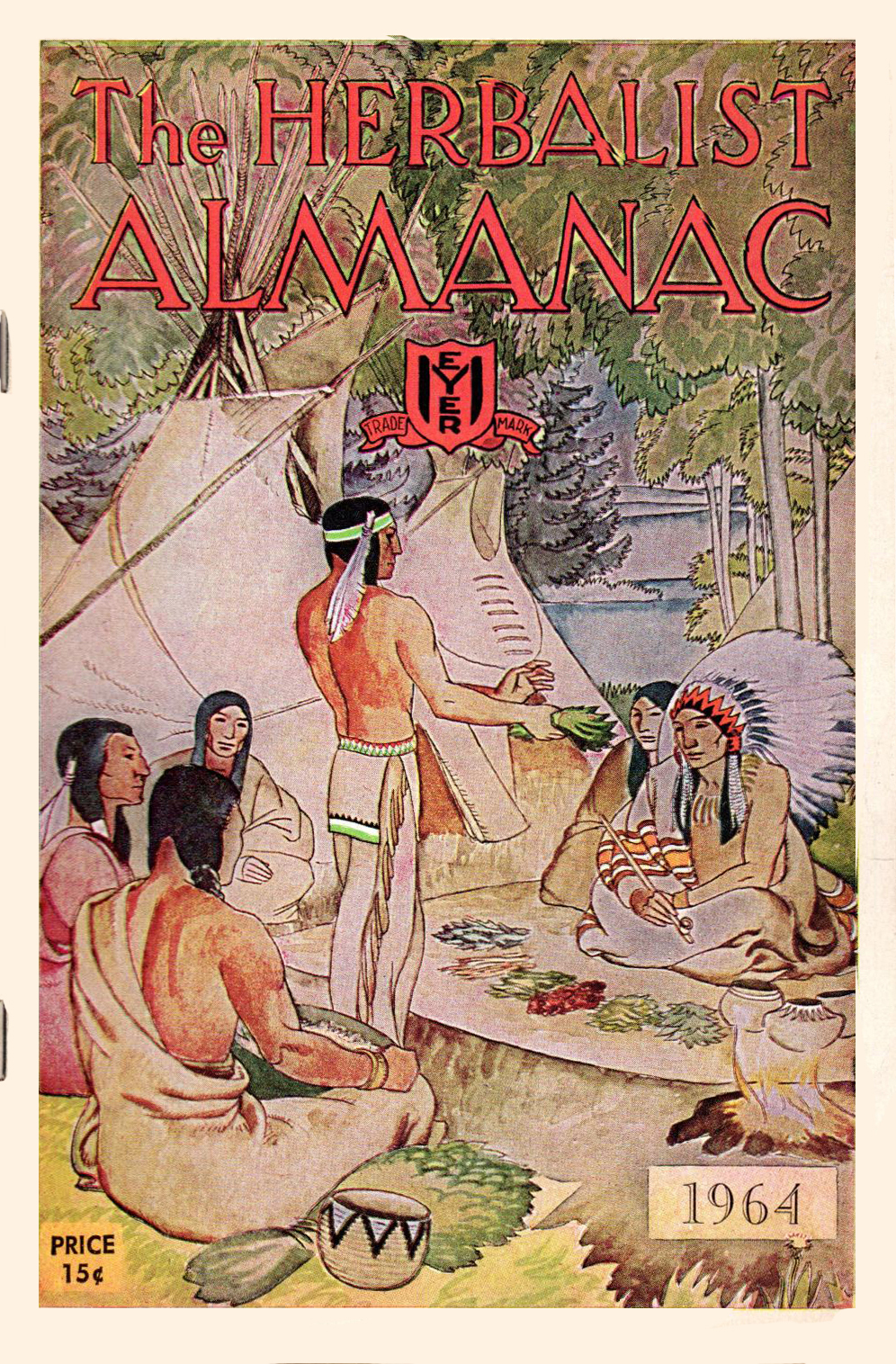
A Life Well-Lived
So those were some of the well-deserved memorials given to Joseph E. Meyer from his employees, family, and business associates.
And now, you may wonder, what did this man do for hoodoo? Why was Indiana Botanic Gardens so much more influential in the Black community than the equally well-stocked stores of other botanical suppliers? The reason will be made abundantly clear when i return with Part Two of this story. But for now, not to leave you in suspense, i will simply note that Joseph Meyer supplied conjure herbs and roots to dozens of hoodoo drug stores and metaphysical shops, sold them by retail mail order to thousands of small-time hoodoo practitioners, and published many informative articles on folk magic and divination amidst his listings for herbal medicines.
To Discuss This Patreon Page
This Patreon Bonus Page is part of the series titled "Leaves from the Root Doctor's Garden." To discuss it with me and the Patron community, please visit our Privae Patreon Forum at
Private Patreon Forum for"Leaves from the Root Doctor's Garden"
Thank you, all. And thanks to my dear companion, nagasiva yronwode, for his generous help with transcriptions, image scans, clean-up, and proofreading. We are a team, and although i may seem to be the public face of our Dyadic Duo, i could not do what i do without him.
